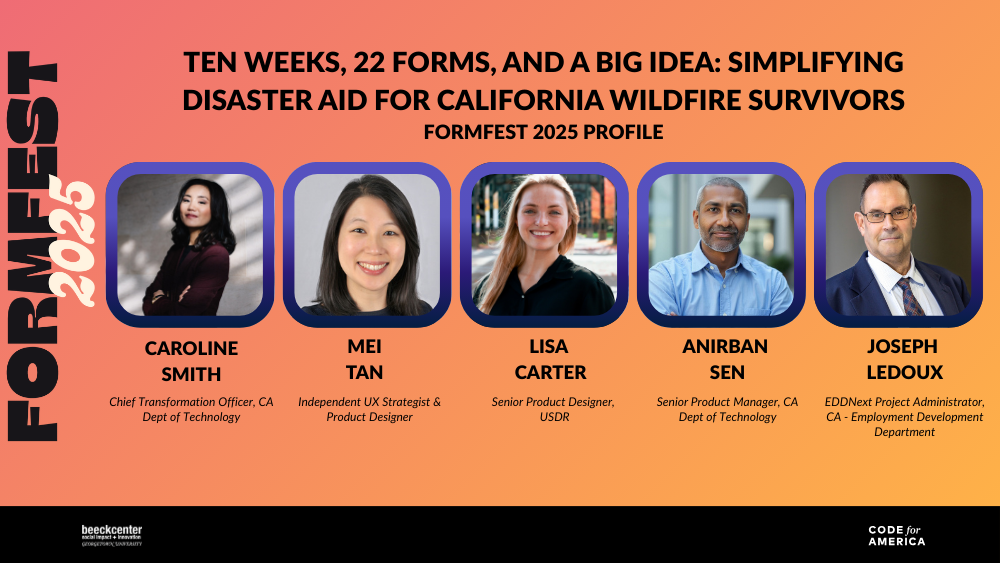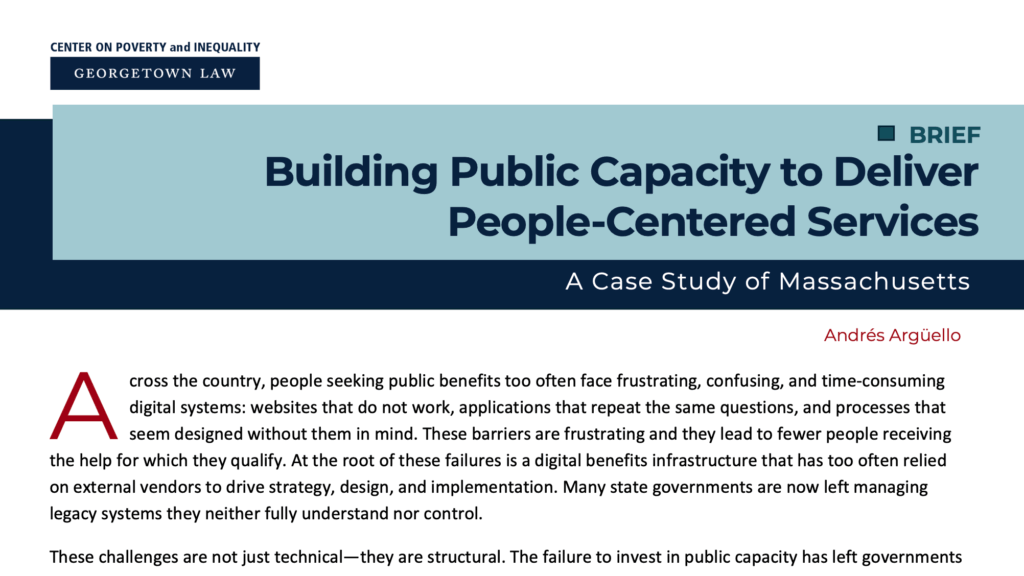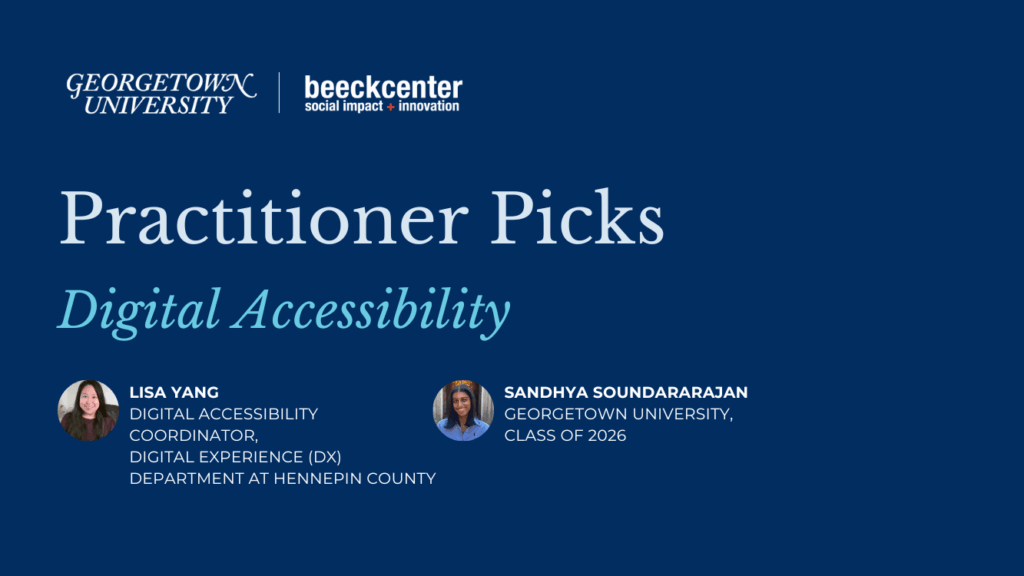FormFest 2024 Recap: Form Accessibility Improvements
An event recap from one of FormFest 2024’s breakout sessions featuring speakers from Government of British Columbia and the State of Wisconsin.
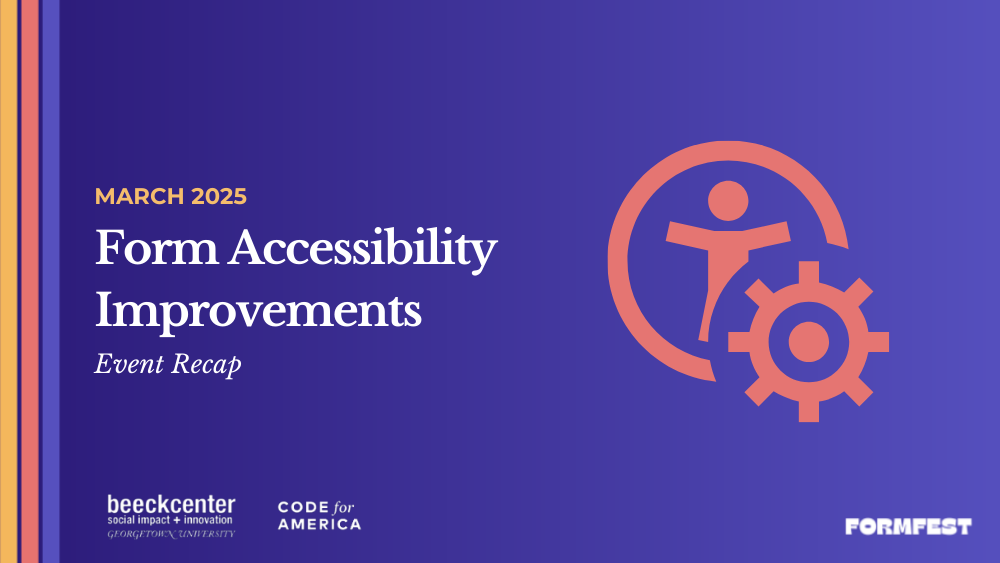
Attendees of this FormFest 2024 panel learned about incorporating best accessibility practices into government forms. The session featured British Columbia’s work to improve legal form usability and tips from the Wisconsin Department of Public Instruction on making forms more accessible overall.
Balancing Act: Redesigning Legal Forms for Usability
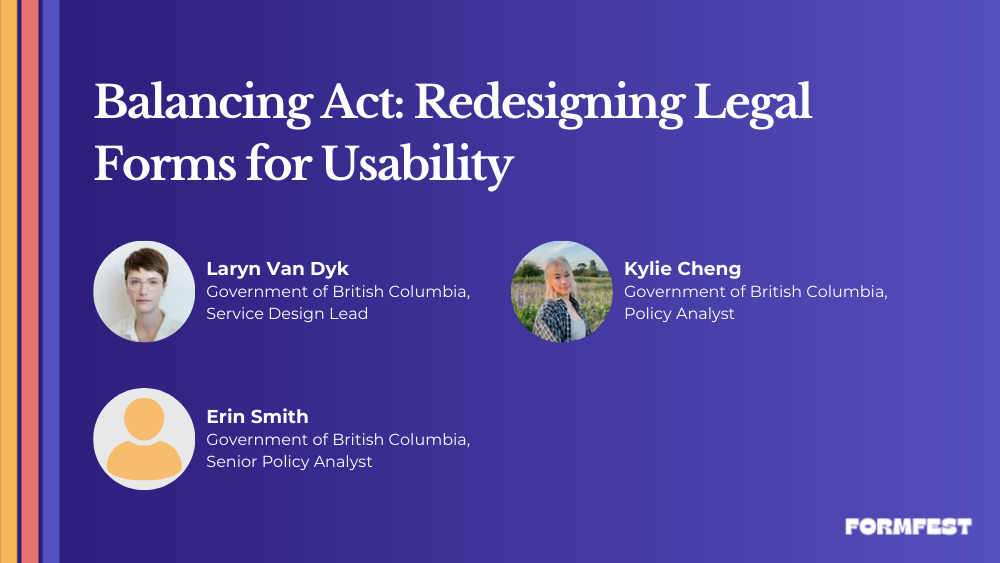
In this session, Laryn Van Dyk, Erin Smith, and Kylie Cheng from the British Columbia Public Service’s Justice Services branch shared their project redesigning the Provincial Court Family Rules forms. This project required carefully weighing legal policy requirements with service design to develop a new paper form that worked for a diverse set of users. The project specifically looked to improve the user experience for self-represented individuals by making the forms more intuitive while ensuring they met legal standards. This work is significant because in 2021, 40% of appearances in provincial court family matters involved a party not represented by a lawyer. In 2019, this number jumped to 58%. These statistics emphasize the need to create justice systems that better support all users in their access to justice, which is defined as the ability to understand and use a legal system to protect an individual’s rights, resolve disputes, and obtain fair outcomes.
Focused on leveraging user-centered research to increase access to justice, the team engaged in conversations with various stakeholders and surveyed a broad range of users, including public court staff, lawyers, and judges. This helped the team learn about the current user experience and identify specific usability challenges that made these forms difficult for many to navigate. They started by collaborating with a policy team to combine policy expertise with design know-how to maintain policy requirements while meeting user needs. Next, the team collected user feedback through five different surveys, each targeted at a distinct user group. These surveys resulted in 147 responses and 750 unique data points. They also facilitated collaborative workshops with advisory groups and used affinity mapping and a how-might-we activity to determine pain points and highlight opportunities for solution design. This feedback allowed the team to shape their prototype design process. They improved the form by removing and consolidating content, rewriting content in plain language, adding a sidebar with legal definitions and helpful tips, and employing visual cues such as page numbers and highlighted headings to give the form a more intuitive structure. After integrating these changes into the form, the team held a public user testing session in Vancouver, where six participants helped them uncover usability issues and understand the improved user experience.
To wrap up this presentation, Van Dyke shared some challenges and lessons with attendees. She noted the hurdles her team encountered with time management, including balancing time-intensive work with test constraints and actually making time for behind-the-scenes work. The key takeaway for organizations looking to replicate this work is to budget enough time to account for the user testing process. Additionally, Van Dyke mentioned that this project taught her team the importance of change management – a structural, person-first approach to navigating organizational changes. She noted that adopting new forms requires cultural and procedural shifts, not just technical design changes. Lastly, she highlighted that listening shouldn’t end with user testing, but should be an iterative process to help ensure long-term success. Overall, the team’s approach of aligning service design with policy expertise to develop and test new forms allowed them to increase access to justice in Canada by ensuring people had fair and equal access to legal help.
Accessibility-First Design for Documents
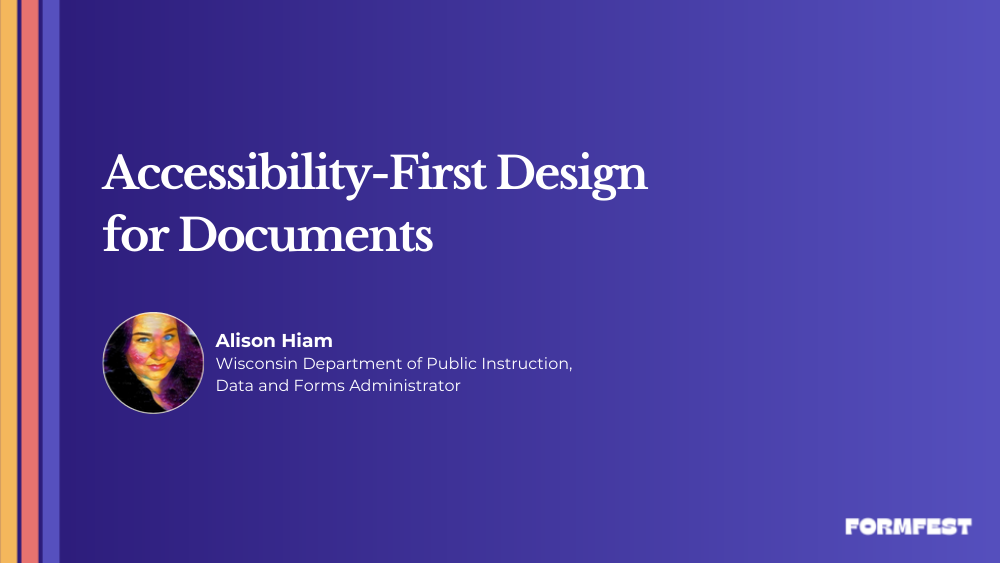
In this presentation, the Wisconsin Department of Public Instruction’s Data and Forms Administrator Alison Haim (she/they) shared accessibility best practices that organizations can use to deepen their understanding of accessibility and improve design choices. Given that forms play a key role in her work, Haim emphasized her philosophy of minimizing the impact of forms on people and reducing barriers in government forms. They stressed the importance of prioritizing accessibility from the start, rather than treating it as an afterthought.
When thinking about accessibility, Haim said it is important to recognize that accessibility can mean different things in different contexts. For example, Haim defines accessibility as a document or presentation, where information, content, and meaning can be equally accessed by all individuals regardless of organic or functional disabilities. Working towards this type of accessibility is important because accessibility improvements often impact more than just the intended audience. For example, Haim noted that making something accessible for screen readers enhances usability for keyboard-only users and improves readability for everyone. They also noted that plain language benefits not only users but also staff, who receive fewer questions about document or website content.
Next, Haim discussed when and where accessibility should be prioritized, noting that not everything needs to be made accessible. Sometimes, removing certain elements entirely can improve accessibility. However, if something is included in a form or document, it should be accessible to all. When evaluating accessibility needs, the answer is simple: everything included in a form should be accessible.
Switching gears to when organizations should think about accessibility, Haim said it’s important to build time in to review accessibility when planning projects. She suggested using built-in accessibility checkers, such as those included in Microsoft Word or Adobe, and cross-checking them with external checkers such as the 2024 PDF Accessibility Checker (PAC). She said it was important to remember that compliance does not guarantee accessibility, and accessibility does not necessarily mean it’s user-friendly. It is important to prioritize good design over planning time to remedy something that is broken.
To wrap up the presentation, Haim shared a few tangible changes organizations could implement to improve the accessibility of their forms. They shared the following checklist to help organizations navigate some of the most common accessibility challenges:
- Structure content with headings, lists, and table headers.
- Write meaningful hyperlinks that work out of context, rather than “Click here to learn more.”
- Write alternative text that describes what each image means in-context.
- Use text. Avoid images of text.
- Use high-contrast colors. Check color contrast with eyedropper tools.
- Do not rely on color alone (green to mean correct) or a single sensory characteristic (“at left”) to convey meaning.
- Provide captions or transcripts for videos and audio.
- Tag language switches, or “Español” becomes “a spaniel.”
By using these helpful tricks, organizations can improve the user experience for everyone. To conclude, Hiam referred individuals interested in learning more to the Web Content Accessibility Guidelines’ (WCAG) website that hosts helpful guidelines, checklists, and tools for improving digital accessibility.
Key Takeaways
- Prioritize diverse user needs. Build time into your design process to find solutions to address the needs of multiple user groups, paying special attention to solutions that increase access for a wide variety of users. Remember to put accessibility first, instead of including it as an afterthought in product design. Don’t be afraid to break down silos and collaborate to better understand the impacts of your form.
- Leverage visual cues. Adding clear visual cues—such as bolding, italics, page numbers, varying font sizes, and different shading boxes—can better highlight key information and break up content to help users focus on what matters most. Using headings, templates, preset styles, and lists can additionally help audiences find important details easier. If you are having trouble creating consistent visuals, Hiam recommends adding your organization’s style guide to the preset styles in your form builder.
- Don’t let perfection get in the way of progress. It’s easy to get overwhelmed when it comes to increasing equity and accessibility. Remember that simple changes can make a big difference. Focus on making incremental change and working through things step by step. You might not be able to make all forms accessible tomorrow, but you can make the form you create tomorrow accessible.
See more from this session at FormFest 2024:
Watch the session recording and more from FormFest 2024.
Form Accessibility Improvements
This session from FormFest 2024 focuses on accessibility, featuring British Columbia’s work to improve legal form usability and tips from the Wisconsin Department of Public Instruction on making forms more accessible overall.
About FormFest
FormFest is a free virtual event showcasing governments working to make services accessible to everyone through online forms. Discover best practices and tools that are shaping the future of form design and service delivery.
